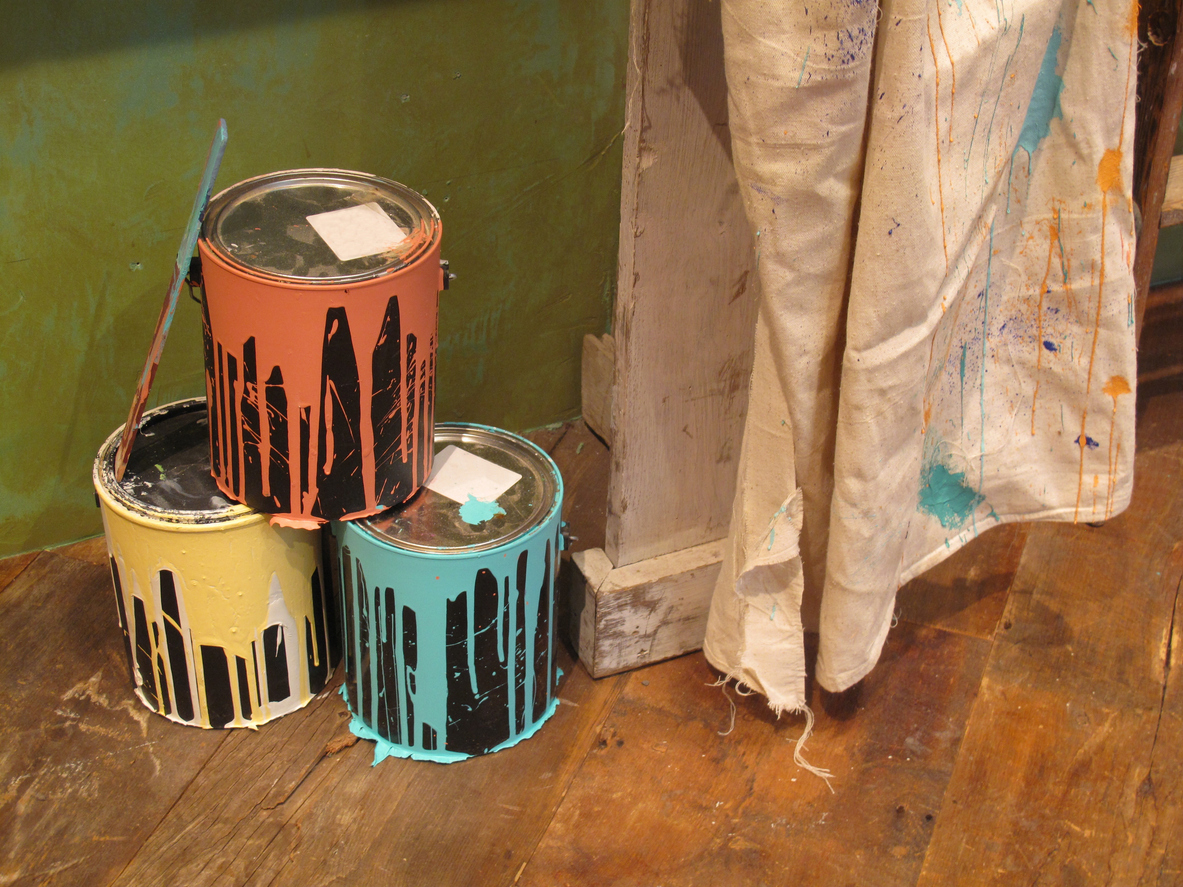Painting is important in personalizing a new home. It enables individuals to express their style and preferences. Painting creates an inviting and comfortable living space mirroring the homeowner’s unique personality and style.
Planning your Painting Project
Here’s a general overview of your requested topics for a home painting project:
Setting goals and vision
- Defining the project’s purpose – Know your goal. Is it aesthetic (improving your home’s visual appeal)? Is it protective (protecting the surface from damage)? Or do you want both goals? It will guide your choice of paint colors, finishes, and methods.
- Choosing a color scheme—When choosing your new color scheme, consider your personal taste and your home’s architectural style. Take a look around your home or observe neighboring homes. Using color swatches lets you see how potential choices work in different lighting conditions.
Budgeting
- Estimating costs – Calculate the costs of paint, supplies (brushes, rollers, drop cloths), and potential professional help. Factor in the size of the project and the quality of materials for a more accurate estimate.
- Saving money – Look for sales on paint and supplies and consider buying in bulk. Compare prices across various stores. Choose quality materials that can last longer and save you money in the long run.
Scheduling the project
- Best times of the year for indoor and outdoor painting – For outdoor painting, choose dry and mild weather seasons (spring or fall) to avoid extreme heat, cold, or humidity. Any time is suitable for indoor painting but ensures proper ventilation.
- Planning the project timeline – Consider personal and work commitments to avoid scheduling conflicts. Break the project into manageable phases. Allocate sufficient time for each phase, including preparation and drying time. Adjust the schedule to accommodate unexpected delays.
Choosing the Right Paint and Tools
Types of paint
1. Oil-based paints
- Made with solvents like mineral spirits.
- Offering a smooth finish and is durable.
- Taking longer to dry and requires paint thinners, turpentines, and mineral spirits for cleanup.
- Emitting strong odors and VOCs (volatile organic compounds).
2. Water-based paints
- Also known as latex or acrylic paints.
- Quick drying, easy to clean up with soap and water.
- Lower VOC emissions and less odor.
- Suitable for interior and exterior projects.
3. Specialty paints
- Chalk paints offer a matte finish and can be distressed for a vintage look.
- Magnetic paints contain iron particles, making it possible to attach magnets to the surface.
- Textured paints add visual and tactile texture to walls or furniture.
Selecting colors
Psychological effects of colors
- Warm colors – Red, orange, and yellow can evoke energy, excitement, and warmth.
- Cool colors – Blue, green, and purple can bring a sense of calm, relaxation, and serenity.
- Neutral colors – White, beige, and gray are versatile and can create a balanced backdrop.
Role of lighting in color choice
- Natural light can change the appearance of colors throughout the day.
- Artificial lighting (warm or cool) can impact how colors look in a room.
- Tip: Test colors in the intended space and lighting conditions before deciding.
Tools and materials needed
- Brushes – Different sizes are used for different areas; natural bristles are used for oil-based paints and synthetic bristles are used for water-based paints.
- Rollers – Different nap lengths are available for smooth or textured surfaces.
- Painter’s tape – This is used to achieve clean lines and to protect areas from paint.
- Drop cloths – To protect floors and furniture from paint splatters.
- Other supplies – Paint trays, stirring sticks, sandpaper, and safety gear (gloves, masks).
Eco-friendly and high-quality products
- Paints – Look for low-VOC or zero-VOC options that are better for health and the environment.
- Brushes and rollers – Choose reusable and high-quality options to reduce waste.
- Painter’s tape – Opt for biodegradable or reusable tape when possible.
- Drop cloths – Use reusable cloth drop cloths instead of disposable plastic.
Preparation Steps
Here’s a general overview of the steps for preparing a room for painting and achieving a smooth application:
Preparing the room
1. Cleaning walls, fixing holes, and sanding surfaces
- Clean the walls with mild soap and water to remove dust, dirt, and grime, and let the walls dry completely.
- Inspect the walls for any holes, cracks, or dents.
- Use spackle or filler to repair any imperfections.
- Allow the filler to dry, and then sand the area until smooth.
- Sand the entire surface lightly to create a better grip for the paint and remove any rough spots.
2. Protecting furniture, flooring, and fixtures
- Remove or move furniture out of the room if possible. Cover any remaining furniture with drop cloths or plastic sheets.
- Use painter’s tape to protect baseboards, trim, windows, and door frames. Lay down drop cloths or plastic sheets to protect the floor from paint splatters.
- Cover light fixtures, doorknobs, and other fixtures with painter’s tape or plastic.
Surface preparation
1. The importance of primer and how to apply it
- Primer is essential for sealing the surface, improving paint adhesion, and ensuring even paint coverage. It can also help hide stains and imperfections.
- Choose a primer appropriate for the surface and the type of paint you’ll use.
- Depending on the surface area, apply the primer using a brush or roller. Allow the primer to dry according to the manufacturer’s instructions.
2. Techniques for a smooth application
- Use top-quality brushes and rollers for a smooth and even application. Choose the right size and type of brush or roller for the surface you’re working on.
- Start painting from the top and work your way down to the bottom. Apply the paint in smooth and even strokes. Roll paint on walls using a “W” or “M” pattern to ensure even coverage.
- Allow the paint to dry completely between coats. Lightly sand the surface (if necessary) to achieve a smooth finish before applying the next coat.
Painting Techniques
Brush and roller techniques
Brushing vs. rolling:
- Brushing – Brushes are ideal for smaller areas, detailed work, corners, and edges. They’re also great for intricate designs and tight spaces.
- Rolling – Rollers are perfect for covering large, flat surfaces quickly and evenly. They work well on walls and ceilings.
Tips for achieving even coverage and avoiding streaks
- Load the brush or roller evenly with paint and tap off excess paint.
- For brushing, use smooth, even strokes. Try to follow the wood grain or direction of the surface.
- Use a “W” or “M” pattern to apply paint for rolling. Fill in the gaps with even strokes.
- Overlap strokes to blend the paint and avoid lap marks.
- Maintain consistent pressure and speed for smooth application.
Using painter’s tape
Techniques for crisp edges and professional-looking results
- Choose high-quality painter’s tape designed for your specific surface and use case.
- Apply the tape carefully along the edges. It ensures the tape firmly adheres to the surface.
- Use a putty knife or credit card to press the tape down firmly and ensure a tight seal.
- Remove the tape while the paint is still slightly wet to avoid peeling off dry paint.
- Pull the tape slowly and at a 45-degree angle away from the painted area.
Specialty finishes
1. Sponging
- Apply a base paint coat and allow it to dry.
- Use a natural sea sponge to dab a contrasting color onto the surface.
- Dab the sponge randomly, varying the pressure for a more natural look.
2. Stenciling
- Secure the stencil in place with painter’s tape.
- Use a stencil brush or foam roller to apply paint over the stencil.
- Apply paint lightly to avoid bleeding under the stencil.
- Carefully remove the stencil as the paint dries.
3. Striping
- Measure and mark your stripes with a level and pencil.
- Mark off the areas you want to paint using painter’s tape.
- Paint the stripes with a brush or roller and remove the tape while the paint is still slightly wet.
- Allow the paint to dry before painting adjacent stripes if necessary.
Dealing with Common Challenges
Managing drips and spills
- Quick solutions – Blot drips or spills immediately with a clean, dry cloth or paper towel. For fresh paint, a wet rag can help wipe it up. For dried paint, gently scrape the paint away with a putty knife or utility blade. Then, touch up the area with a small brush.
Overcoming uneven coverage
- Deal with patchy results – Apply a second or even third coat to ensure uniform coverage. Make sure the previous coat is fully dry before applying another. Choose a quality paint and use the recommended tools for your paint type (roller, brush, or spray).
- Tips for uniform appearance – Work in sections, keeping a wet edge to blend the paint as you go. Use a primer if the surface is particularly porous or stained. Maintain a consistent speed and pressure when painting for a smooth finish.
Post-Painting: Cleanup and Maintenance
Here is how you can handle cleaning up and maintaining painted surfaces:
Cleaning up
- Safe disposal of paint and materials – Check local regulations for paint disposal. Take unused paints to a hazardous waste facility. Never pour paint down the drain. Allow paint-soaked materials to dry before disposing of them in the trash.
- Cleaning brushes, rollers, and trays – Clean these tools immediately after use to prolong their life.
- Use soap and warm water to wash the brushes, rollers, and trays for water-based paints.
- For oil-based paints, use turpentine, mineral spirits, or paint thinner. Rinse thoroughly and dry properly before storing.
Maintaining painted surfaces
- Routine maintenance tips to prolong paint life – Regularly dust and clean painted surfaces with a soft, damp cloth. Avoid using harsh cleaning products that can damage the paint. Check for signs of chipping or cracking and address them promptly.
- Touch-up strategies – Keep a small amount of touch-up paint from your initial project for future use. Ensure the paint is mixed thoroughly and matches the original color. Apply paint with a small brush or sponge to blend the touch-up with the surrounding area.
Conclusion
House painting takes a lot of patience and attention to detail. However, they can help you change your home’s look to one that best suits your style. Don’t hesitate to experiment with colors and techniques. This is your chance to express creativity and make your home truly your own. Enjoy transforming your new home and the satisfaction of a job well done!
Otherwise, hire painters to give your new home a professionally done paint job. Custom Painting, Inc. can maintain or restore your home’s original stability, appearance, and beauty and extend its life. Please call us at 925-686-0903 or complete our online contact form for a free estimate on your next house painting project.




